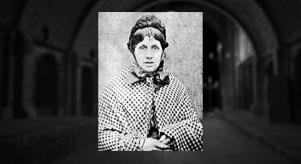
A Noble Death
Throughout history, there have been many murky cases and shadowy disappearances surrounding the gentry. We’ve found four of the most interesting cases to share with you. Read on to find out about the mysterious deaths of the 10th Earl of Shaftesbury and Crown Prince Rudolf of Austria, the mystery surrounding Lord Lucan and the many murders committed by Countess Elizabeth Bathory, otherwise known as The Blood Countess.
On 5 April 2005, the decomposed and almost skeletal body of Anthony Ashley-Cooper, the 10th Earl of Shaftesbury, was found under a Laurel tree in the South of France after he’d been missing for 5 months, but how did he get there? After the death of his mother, whom he was very close to, Anthony’s life went into a sharp decline. He left his seat at the family estate in Dorset, left the running of the grounds to his second wife, Christina, and handed his Earldom down to his eldest son. Anthony took to the bachelor life rapidly, spending his ‘old-money’ lavishing it on expensive champagne for prostitutes in London, Brighton and his new almost-home, the French Riviera.
It was here that he met Jamila M’Barek, a divorced mother of two, and nightclub hostess. The pair married in the Netherlands in 2002, despite Anthony’s family disapproving of the match, as they believe she just wanted the title and fortune and cared little for her new husband. However, the relationship was only to last 2 years. Jamila was unhappy with Anthony’s lifestyle, and he found her cold, and heartless, and constantly focused on his possessions and wealth. He was set to marry another hostess once their divorce went through.
On 5 November 2004, Anthony went to the £500,000 flat in Cannes he had bought for Jamila to discuss divorce proceedings and express his desire to marry again, and was never seen alive again. 5 months later, his decomposed body was discovered in a remote Ravine at the foot of the French Alps. Pathologists say that the double fracture to his larynx suggests that he was strangled to death. Originally, police suspected that Anthony had become a victim of the insidious underworld of the French Riviera and had been killed by the mafia. However, it wasn’t long until Jamila became a prime suspect. She spent a short time in a psychiatric unit where she was secretly bugged by police, who heard her telling her sister that she paid her brother £100,000 to kill Anthony. In court, Jamila’s brother, Muhammad, confessed to the crime, but not to strangling Anthony. He claimed that they were fighting and Anthony fell and died of a heart attack. He vehemently denied that Jamila had anything to do with it at all.
On 25 May 2007, the jury returned guilty verdicts against the pair, based on the wealth of evidence against them. Jamila is currently serving 20 years behind bars, and Muhammad is serving 25.
The Mayerling incident refers to the series of events leading up to and including the supposed murder-suicide of Crown Prince Rudolf of Austria and his lover, Baroness Mary Vestera. The bodies of the Prince (30) and his lover (17) were discovered in the royal family’s hunting lodge at Mayerling. But who killed them? The death of the Crown Prince had a profound effect on the already strained relationship between his parents, and grossly interrupted their family’s succession line.
As Prince Rudolf had no son, the succession would then pass to his uncle, Karl Ludwig, and his son, Archduke Franz Ferdinand. This shift in succession damaged the reconciliation with Austrian and Hungarian sectors of the Empire and essentially developed into a catalyst for the assassination of Franz Ferdinand, and consequentially, the First World War. At the time of his death, many people at Court, including his parents and wife, were aware of Rudolf’s affair with Mary. On 29 January 1889 he excused himself from a dinner party thrown by his parents, and headed to Mayerling with the intention of going shooting early the following morning. When his valet and hunting companion went to call on him, there was no answer. Several minutes later, they frantically smashed through the door with an axe and were greeted with the bodies of Rudolf and Mary. Rudolf’s body was found sitting, motionless beside the bed. He was bleeding from the mouth.
Mary was lying on the bed, white and ice cold. The valet and his companion assumed that poison was involved as there was a glass and a mirror on the table next to Rudolf. For some time, many people assumed that Mary had killed Rudolf and then herself. They assumed that the Prince was given Strychnine as that causes bleeding. Publically, it was declared that Rudolf died suddenly of an aneurism, however, talk of Mary’s involvement in his death soon began to circulate. At this stage, at the request of the Emperor, the Police changed their public story. The official line is that, after being told they had to end their illicit relationship, the pair retreated to the hunting lodge where Rupert shot Mary, and then later shot himself. The case was then closed. To this day, it is still unclear what happened in that hunting lodge, though most historians have dismissed that this is any more than a simple murder-suicide. Many people believe that the original theory (Mary poisoned Rudolf and then herself) is the most likely.
The7th Earl of Lucan famously disappeared after the murder of his children’s nanny in 1974. He has not been seen since and was declared legally dead in 1999. In 2012, claims came about that he had fled to Africa after the murder. Richard John Bingham, 7th Earl of Lucan was an Eton educated noble, mostly living in London. He was described as a charismatic man with expensive tastes; indeed, he had a penchant for gambling and was skilled at backgammon and bridge. At one point, he was considered for the role of James Bond! Fittingly, he drove an Aston Martin. He married Veronica Duncan in 1963 and they had 3 children together. Unfortunately, their marriage collapsed in 1972, and he moved out of the family home, preceding a difficult and bitter custody battle. Lucan lost the battle, and it began to take over his life. He started spying on his wife, recording their telephone conversations, spying on the family home, and obsessing over regaining custody of his children.
This custody battle marked the beginning of a sharp decline for Lucan. He began to make great gambling losses and lost control of his personal finances. Finally, on the night of 7 November 1974, the children’s nanny, Sandra Rivett, was bludgeoned to death by a man in the basement of the family home. Lady Lucan, who entered the basement to find what was taking Sandra so long, was also attacked, and she identified their attacker to the police as Lord Lucan.
Later that night, Lucan called his mother to tell her that Lady Lucan had been injured, asking her to collect the children, then borrowed a car and headed to a friend’s house in Sussex. Hours later, he left the property and has never been seen again. Despite an intense police investigation and masses of press interest, no trace of Lucan has ever been found and he is now presumed dead. He told friends that he had been passing the house late at night and had noticed his wife struggling with another man. He went in to help and slipped in a pool of blood. When the man ran out, his wife became hysterical and accused him of hiring someone to kill her. He realised at this point it would be best if he left the house. Lucan’s borrowed car was discovered several days later, with a similar lead pipe inside, providing further evidence for the coming trial. Testimony from Lady Lucan and other witnesses and some forensic evidence the jury returned a verdict that Lord Lucan was guilty of murder.
There are several different suggestions as to the whereabouts of Lord Lucan. Many people say that it is most likely that he killed himself shortly after the murder, however it was widely rumoured that he managed to escape the country. There have been several sightings over the years, reaching as far as Australia and South Africa.
Elizabeth Bathory, born in 1560, is widely renowned as the most prolific and sadistic female serial killer of all time, earning herself the moniker: ‘The Blood Countess’. Her early life was somewhat out of the ordinary. Obviously, being a member of the nobility, she led a very privileged life, wanting for nothing, though some of her ancestors were reportedly rather shady characters. She had an aunt who practiced witchcraft; an uncle who was a devil worshiper and her brother was a renowned pedophile. She suffered tremendous fits as a child, that many believe were a sign of a neurological disorder or epilepsy, and it is said that her childhood nurse practiced black magic that involved the sacrifice of children for their bones and blood. Elizabeth was married at the age of 15 and spent the majority of her time alone, as her husband was often away at war.
In 1610, rumours of her sadistic conduct were beginning to circulate around court, and the authorities and the King ordered an investigation. Testimonies were taken from over 300 witnesses. The authorities arrived at her castle to arrest her and her accomplices, and immediately found one dead girl, one dying and several wounded and imprisoned.
Between the years of 1585 and 1610 it is reported that Elizabeth and her servants brutally abused, attacked and murdered around 650 young girls – though they were only officially convicted of killing 80. Elizabeth’s servants were sentenced to death, but due to her nobility, she was imprisoned in her own castle, where she died naturally four years later. On further investigation, somewhere between 100 and 200 bodies of the young girls she had tortured and killed were removed from her residence. Her personal journal was used as evidence during her trial, where she personally detailed her torture of more than 650 girls, and explained how she used to enjoy bathing in the blood of virgins. Her story has been passed down through history, and some reports have evolved over time. Though we can’t be sure whether it’s completely true, many people say that she developed a fondness for drinking the blood of her victims, with many generations referring to her as ‘Countess Dracula’.




